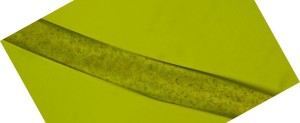
Polyester Fiber (Wikipedia Commons [PD]), from photo by Edward Dowlman, taken at Strathclyde University
Polyester, sometimes just called “poly,” is a long-chain polymer. According to the Federal Trade Commission, a polymer has to be at least 85% esters to be classified as polyester. There are several kinds of polyester, but the kind abbreviated PET is made into fabrics. PET is also the substance of plastic beverage bottles, which can be recycled into fabrics.
Polyester is made by reactions of alcohols and acids, usually derived from petroleum or coal. The initial reactions were discovered in the 1930s by W.H. Carothers, a DuPont chemist, who found that when carboxyl acid and alcohol were mixed they could produce fibers. Nylon was developed at the same time, so polyester was forgotten for a while. But in 1941, British chemists rediscovered the reactions and began producing polyester fibers. DuPont bought the rights in 1946 and began developing polyester for textiles.
Polyester (also called “poly”) began to be used in clothing in 1961 as Dacron. It was washable and wrinkle-free, needed no ironing, kept its color, and dried quickly. It could also be blended with natural fibers, such as cotton or wool, making them wrinkle-resistant and more durable. Poly-cotton is a commonly used fabric today. The ratio of polyester is usually between 15 and 65 percent.
Polyester and poly-cotton are frequently used in mattress covers. Of bedding manufacturers reviewed on Beds.Org, at least 33 use polyester or poly blends in their cover materials. At least one manufacturer, WJ Southard, refuses to use polyester.
Besides fabrics, filling and insulating material (also called “polyfill”) are made of polyester. Polyester fibers can be any shape the extrusion nozzle can be cut into, even hollow tubes. It can be heat set to any shape, such as crinkled. Tubular and crinkled fibers are highly insulating as well as filling. Several mattress manufacturers use polyfill, often in the quilting.
For now it appears that polyester is here to stay, blended with natural fibers or on its own. It offers desirable qualities at affordable cost. It is also easily recycled. It can be designed to have the characteristics of natural fibers, such as cotton, linen, wool or silk. It can also imitate the semi-synthetic fiber rayon (extracted wood cellulose). As to being a petroleum product, it may someday be made from plant-derived materials.
This entry was posted on Friday, August 29th, 2014 at 2:48 PM and is filed under batting, beds, fabrics, fabrics, mattress covers, quilting . You can follow any responses to this entry through the RSS 2.0 feed. You can leave a response, or trackback from your own site.

Get New Post Notification via Email:

12 thoughts on “Polyester”